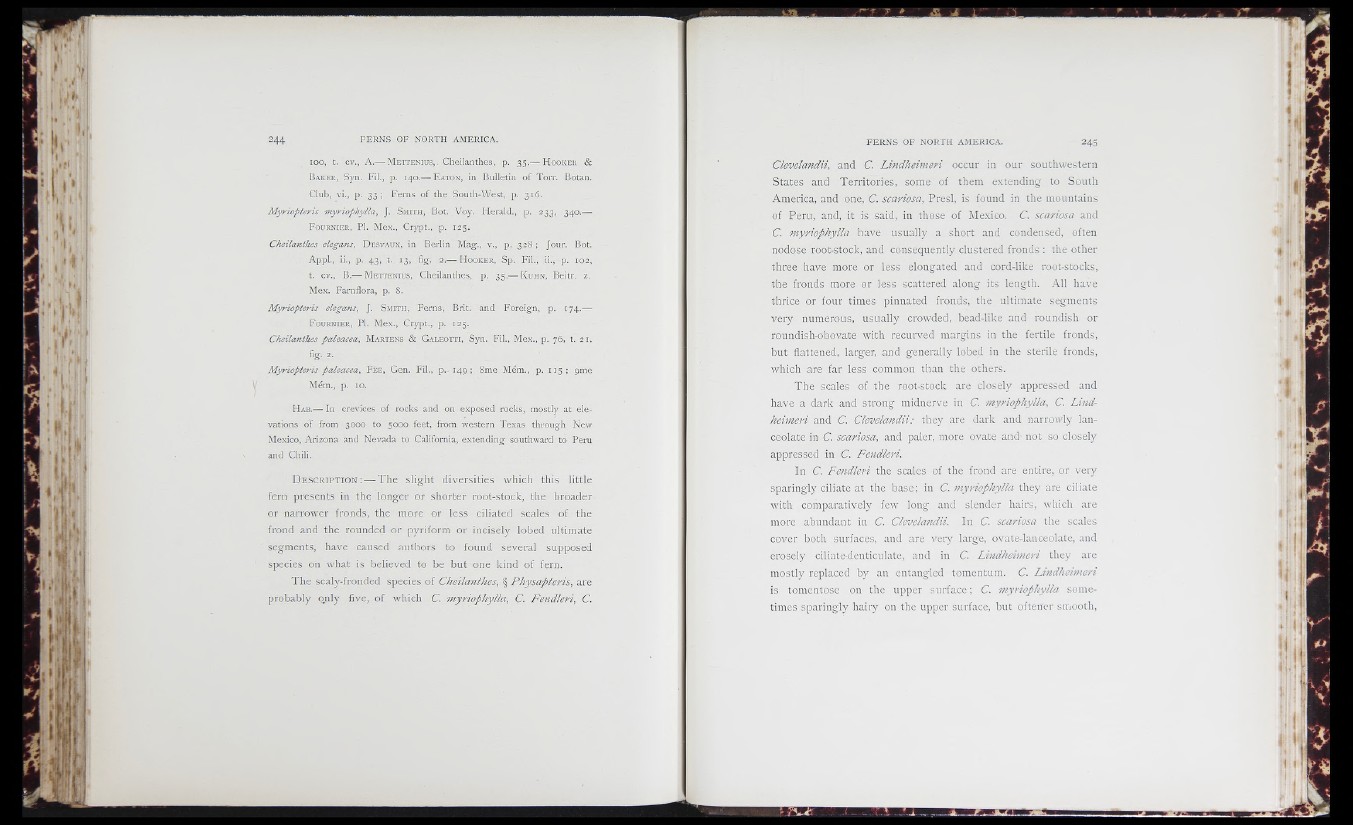
t V
¡' ! \ ; l
, f h \
A i
k '
1 : 1 ;
I
, i
100, t. cv., A.— M e t t e n iu s , . Cheilanthes, p. 35.— H o o k e r &
B a k e r , Syn. Fil., p. 140.— E aton , in Bulletin of T o it . Botan.
Club, vi., p. 33 ; Ferns of the South-West, p. 316.
Myriopieris myriophylla, J. S m ith , Bot. Voy. Herald., p. 233, 340.—
F o u r n ie r , PI. Mex., Crypt., p. 125.
Cheilanthes elegans, D e sv a u x , in Berlin Mag., v ., p. 3 2 8 ; Jour. Bot.
Appl., ii., p. 43, t. 13 , fig. 2.— H o o k e r , Sp. Fil., ii., p. 102,
t. cv., B.— M e t t e n iu s , Cheilanthes, p. 35.— K u h n , Beitr. z.
Mex. Farnfiora, p. 8.
Myriopteris elegans, J. S m it h , Ferns, Brit, and P'oreign, p. 174.—
F o u r n ie r , PI. Mex., Crypt., p. 125.
Cheilanthes paleacea. M a r t en s & G a l eo t t i , Syn. Fil., Mex., p. 76, t. 21.
fig. 2.
Myriopteris paleacea. F é e , Gen. Fil., p. 14g ; 8me Mém., p. 1 1 5 ; gme
Mém., p. 10.
H a b .— In crevices of rocks and on exposed rocks, mostly at elevations
of from 3000 to 5000 feet, from western Texas through New
Mexico, Arizona and Nevada to California, extending southward to Peru
and Chili.
D e s c r i p t i o n : — The slight diversities which this little
fern presents in the longer or shorter root-stock, the broader
or narrower fronds, the more or less ciliated scales of the
frond and the rounded or pyriform or incisely lobed ultimate
segments, have caused authors to found several supposed
species on what is believed to be but one kind of fern.
The scaly-fronded species of Cheilanthes, § Physapteris, are
probably only five, of which C. myriophylla, C. Fezidleri, C.
Clevelandii, and C. Lindheimeri occur in our southwestern
States and Territories, some of them extending to South
America, and one, C. scariosa, Presl, is found in the mountains
of Peru, and, it is said, in those of Mexico. C. scariosa and
C. myriophylla have usually a short and condensed, often
nodose root-stock, and consequently clustered fronds : the other
three have more or less elongated and cord-like root-stocks,
the fronds more or less scattered along its length. All have
thrice or four times pinnated fronds, the ultimate segments
very numerous, usually crowded, bead-like and roundish or
roundish-obovate with recurved margins in the fertile fronds,
but fiattened, larger, and generally lobed in the sterile fronds,
which are far less common than the others.
The scales of the root-stock are closely appressed and
have a dark and strong midnerve in C. myriophylla, C. Lindheimeri
and C. Clevelandii: they are dark and narrowly lanceolate
in C. scariosa, and paler, more ovate and not so closely
appressed in C. Fendleri.
In C. Fendleri the scales of the frond are entire, or very
sparingly ciliate at the base; in C. myriophylla they are ciliate
with comparatively few long and slender hairs, which are
more abundant in C. Clevelandii. In C. scariosa the scales
cover both surfaces, and are very large, ovate-lanccolate, and
erosely ciliate-denticulatc, and in C. Lindheimeri they are
mostly replaced by an entangled tomentum. C. Lindheimeri
is tomentose on the upper surface; C. myriophylla sometimes
sparingly hairy on the upper surface, but oftcher smooth,
. i
j